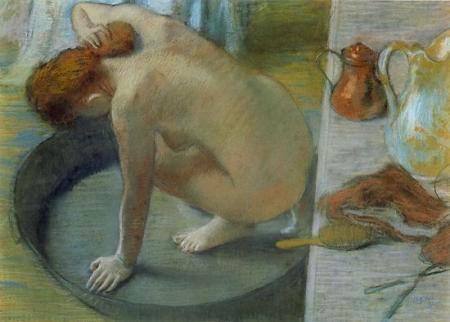
Today’s prompt is inspired by a series of ekphrastic studies I’ve been writing on images of “women at bath.” In compiling these sketches, I’ve observed, among others, paintings by Degas, Picasso and the woodblock artist Hashiguchi Goyo, searching for visual elements that might bring a fuller sense of description to my writing.
The traditional mode of ekphrasis—that is, the “making of poetry from art”—involves describing or imaginatively inhabiting a painting, sculpture or photograph; in this way, the poet more or less lends their descriptive craft to that of the visual artist. What I’ve been investigating, however, is how iconic images (such as Picasso’s “Blue Nude”) can be broken up into elements that recur in various, refracted ways across images, then worked into a poem’s narrative fabric in a way that doesn’t necessarily foreground itself as ekphrasis.
The curve of the woman’s back in the painting above, for instance, is mirrored by the shape of the body in “Blude Nude,” not to mention the statue of Aphrodite crouching at her bath by the ancient Roman sculptor, Praxiteles (from whose influence all these pieces are, quite potentially, derived). The poem I’m currently drafting may not be “about” the woman in Degas’ “The Tub,” and it may not draw direct influences from Picasso or Praxiteles’ work either. But in its descriptive impulses, it incorporates elements common to all these works of art, combining them into a sort of patchworked woman to be stitched into my poem, which stands very much apart from the histor(ies) of these paintings and sculptures.
Prompt: Research a set of paintings (or any other form of visual art) linked by subject matter, time period or even mood, and spend some time observing what features appear in each piece. Describe each work of art on its own and then as it relates to the whole, thinking how these details might serve to “round out” a poem of your own. Soak in the wealth (and variety!) of visual elements present in the paintings, and allow these to strengthen the descriptive or observational moments in your writing.
* * *
For more related reading, see this Friday Prompt on ekphrastic poetry, a list of visual art resources and our March 2010 series on The Page Transformed, in which we posted a number of interviews (with Fiona Sze-Lorrain, for instance) and book reviews (this one features Luisa Igloria’s Juan Luna’s Revolver) themed around the relationship between the making of poetry and visual art.